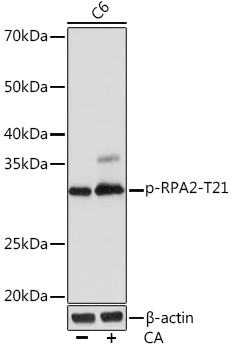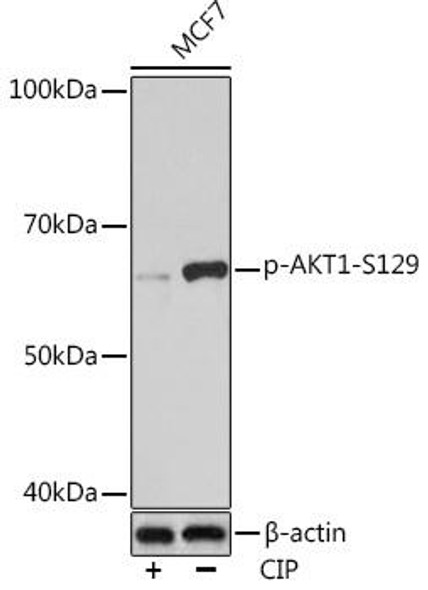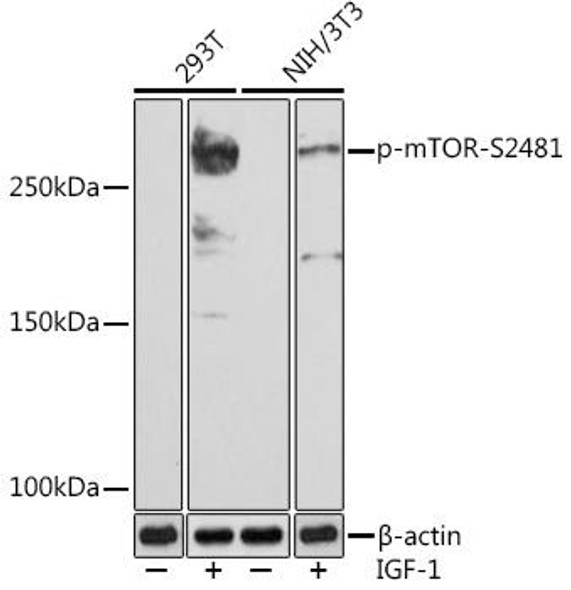Description
Phospho-RPA2-T21 Rabbit Monoclonal Antibody (CABP1040)
The Phospho-RPA2 (T21) Rabbit Monoclonal Antibody (CABP1040) is a valuable tool for researchers studying the phosphorylation of the RPA2 protein at threonine 21. RPA2 is a critical component of the DNA damage response pathway, playing a key role in DNA replication and repair processes. This antibody, produced in rabbits, is highly specific for the phosphorylated form of RPA2 at threonine 21 in human samples. It has been validated for use in Western blot applications, enabling researchers to detect and analyze the phosphorylation status of RPA2 in various cell types.
The phosphorylation of RPA2 at threonine 21 is known to be important in DNA damage signaling and repair mechanisms, making this antibody a valuable tool for studies in DNA damage response, cell cycle regulation, and cancer research. Understanding the role of phosphorylated RPA2 in these processes is crucial for developing targeted therapies and treatments for cancer and other diseases related to DNA damage and repair pathways.
| Product Name: | Phospho-RPA2-T21 Rabbit Monoclonal Antibody |
| SKU: | CABP1040 |
| Size: | 20uL, 100uL |
| Isotype: | IgG |
| Host Species: | Rabbit |
| Reactivity: | Human,Rat |
| Immunogen: | A synthetic phosphorylated peptide around T21 of human RPA2 (P15927). |
| Sequence: | GYTQ S |
| Tested Applications: | WB ELISA |
| Recommended Dilution: | WB,1:500 - 1:1000 |
| Synonyms: | REPA2; RPA32; RP-A p32; RP-A p34; Phospho-RPA2-T21 |
| Positive Sample: | C6,C6+Calyculin A |
| Conjugate: | Unconjugated |
| Cellular Localization: | Nucleus, PML body. |
| Calculated MW: | 29kDa |
| Observed MW: | 32kDa/36kDa |
This gene encodes a subunit of the heterotrimeric Replication Protein A (RPA) complex, which binds to single-stranded DNA (ssDNA), forming a nucleoprotein complex that plays an important role in DNA metabolism, being involved in DNA replication, repair, recombination, telomere maintenance, and co-ordinating the cellular response to DNA damage through activation of the ataxia telangiectasia and Rad3-related protein (ATR) kinase. The RPA complex protects single-stranded DNA from nucleases, prevents formation of secondary structures that would interfere with repair, and co-ordinates the recruitment and departure of different genome maintenance factors. The heterotrimeric complex has two different modes of ssDNA binding, a low-affinity and high-affinity mode, determined by which oligonucleotide/oligosaccharide-binding (OB) domains of the complex are utilized, and differing in the length of DNA bound. This subunit contains a single OB domain that participates in high-affinity DNA binding and also contains a winged helix domain at its carboxy terminus, which interacts with many genome maintenance protein. Post-translational modifications of the RPA complex also plays a role in co-ordinating different damage response pathways.
| Purification Method: | Affinity purification |
| Gene ID: | 6118 |
| Clone Number: | ARC1586 |
| Storage Buffer: | Store at -20℃. Avoid freeze / thaw cycles.Buffer: PBS with 0.02% sodium azide,0.05% BSA,50% glycerol,pH7.3. |











